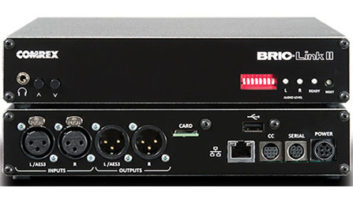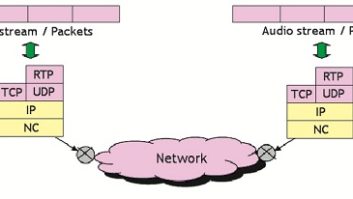IP Broadcasting and Session Initiation Protocol
Jun 1, 2008 12:00 PM, By Glenn Davies
Broadcasting over IP is rapidly becoming the paradigm by which broadcasters are planning future broadcast network infrastructures. Within the diverse range of broadcast IP devices coming onto the market, Session Initiation Protocol (SIP) is currently the signaling protocol used by most of the world’s telcos and broadcast codec manufacturers. It is also the most likely to provide connectivity between IP devices for the foreseeable future.
To understand the context in which SIP is developing as a signaling protocol, it is useful to know some background about SIP, its history and how it is currently used in broadcast products.
What is SIP?
Session Initiation Protocol (SIP) is an open standard application layer signaling protocol used to facilitate connections over IP networks and the Internet. SIP can work with a myriad of other protocols to establish connections between all sorts of different devices, and it is capable of supporting audio, video and instant messaging technologies, without regard for the particular device or the media content delivered. Historically, it has been widely used in VoIP applications. It has also been used for multimedia distribution and multimedia conferencing and can be used to create two-party, multiparty or multicast sessions. More recently, its ability to create and manage connections over the Internet has led to its integration into an increasing number of broadcast audio and video products that stream data packets in broadcast applications.

The functional signal flow of two SIP-enabled codecs connecting via the Internet.
There are two distinct parts to a call when dialing and broadcasting over IP. SIP is used in the initial stage for call setup. The second stage is when data transference occurs, and this is left to the other protocols used by a device (i.e. using UDP to send audio data). SIP only defines the way in which a communication session between devices should be managed. It does not define the type of communication session established.
Broadcast audio codecs can use SIP to make peer-to-peer connections between two codecs. In this scenario, IP addresses are used to dial between two codecs and then SIP uses Session Description Protocol (SDP) to negotiate the features used during a call. This may include the bit-rate of the connection and the algorithm.
One of the challenges in broadcasting audio over the Internet is creating reliable connections that support remote broadcasting from different locations. In the past, broadcasters have used IP addresses as a method of connection but this has been complicated for two reasons. Dynamically assigned IP addresses often change and are therefore not reliable for dialing. In addition, private IP addresses, such as those assigned over private LANs, cannot be dialed directly by a device outside a private LAN. This principle is very similar to dialing a phone’s extension number within a PABX system. Extension numbers within these systems cannot be dialed directly from outside the PABX.
To solve this requires either the programming of a static public IP address into a device like a codec, or the use of Network Address Translation (NAT) and port forwarding to avoid firewall connection issues.
SIP can be used to work around this problem by using a SIP server (registrar) to act as a gateway between public and private IP networks. The first step is to connect each SIP-compliant device to a SIP registrar which assigns SIP addresses (similar to an e-mail address) to a device. Once two devices are SIP-registered they can find each other by connecting to SIP servers and exchanging connection information. This process is displayed in Figure 1 (page 46).
When a SIP call is initiated, a SIP server establishes a device’s location, determines its availability and negotiates the features to be used during a call. Audio is then streamed according to those parameters.
Using SIP in broadcast audio applications
In essence, the future of SIP technology development for broadcasting is being driven by the different approaches required for broadcast applications. Tieline Technology saw the potential of SIP several years ago and has been working on broadcast IP methods using SIP since 2005.
The partners in the Audio-via-IP Experts Group, which includes Tieline, Aeta, Mayah and Orban, see SIP as the future of IP connectivity in broadcasting. The group has been working recently with the EBU to test and develop EBU-approved standards for broadcasting over IP using SIP.
Central to this is the development of common standards of connectivity between manufacturers. From an interoperability perspective, audio codecs using SIP that are EBU compliant should all be able to connect to each other more easily than in the past. Recent interoperability testing by Tieline and eight other European codec manufacturers found they were all able to connect over IP using SIP. These tests used peer-to-peer connections that don’t use SIP servers.
Establishing a SIP Connection
Codecs manufactured by members of the Audio-via-IP Experts Group — AETA, Mayah, Oban/CRL and Tieline — are SIP compliant. This article details the handshaking communication to establish a reliable connection….
On the other hand, SIP-compatible audio codecs registered to SIP servers can simply dial and connect to other codecs and VoIP devices without knowing their IP address. This hugely simplifies remote broadcasting over IP and is particularly useful when broadcast locations are constantly changing.
One current issue is that most current SIP servers are configured for VoIP traffic and provide low quality audio using G.711 or GSM algorithms. For broadcast codecs to take advantage of SIP server connectivity, the SIP server should support higher quality algorithms such as MPEG, AAC and other proprietary ones. This requires a broadcaster to use a more compatible SIP server or transversal server to negotiate higher quality connections.
Broadcasters will also face some other challenges with SIP, including how to deal with Telcos who block SIP traffic. This is done to stop SIP traffic competing with other phone network products and is accomplished by blocking port 5060, which SIP uses to communicate between devices.
Negotiating these challenges will not happen overnight, but, given the flexibility and promise that SIP has displayed, broadcasters will continue to work with the various stakeholders to develop SIP functionality in years to come.
Read the related article “Establishing a SIP connection“
Davies is a technical correspondent for Tieline Technology, Indianapolis.









